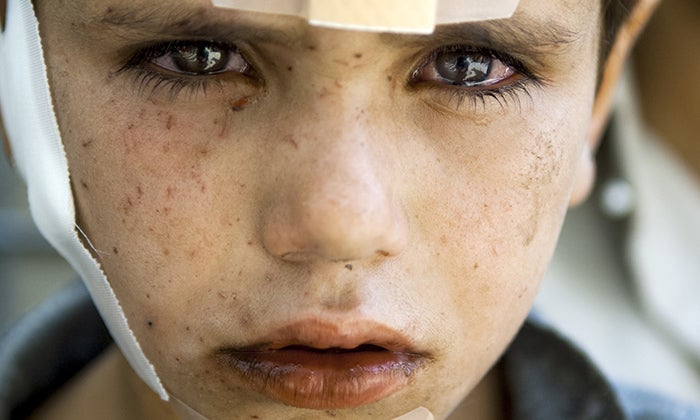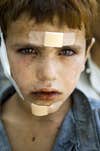It’s What I Do: Powerful Lynsey Addario Memoir Excerpt on Censorship
From the twice-kidnapped photojournalist's new book on finding her way


Congo Rape Victims





Syrian refugees;syrians;jordan






Syruan Refugees;northern iraq
In the centuries-old argument on the death of the novel, modern media theorists had pointed to the newspaper as a source for awe-inspiring stories no creative writer could simply imagine. This ushered in the era of “New Journalism,” but for all the color and syntactical flare that the Tom Wolfes and Hunter Thompsons brought to reportage, what they often failed to reveal was the interiority and perhaps humanity of the narrator/newsgatherer.
Lynsey Addario’s new memoir It’s What I Do: A Photographer’s Life of Love and War (Penguin Press) seems a success on both fronts: a powerful first-hand history of the disastrous first decade of the 21st century, and an honest, brave exploration into the motivation and judgement of those who captured it. Framed with her 2011 kidnapping in Libya, and resolved with the birth of her son less than a year later, the book tracks her navigating between two radically divergent worlds. Through spare, direct, almost caption-like prose, it takes us from the battlefield with its constant snap of Kalashnikov fire hanging over head, to the beaches of Bosphorus and Mexico, the foreign corespondent wine parties, the days between assignments spent “decompressing” with significant others. It offers a profound and refreshing perspective amid the virtual nonexistence of female combat narratives in the western canon.
Here we present an evocative excerpt from Addario’s new book on a moment when the authenticity of one her images (unpublished until now) was called into question, concluding with her unflinching response written to one of the most important editors in the industry.
…I was in Khartoum, Sudan, preparing to go into Darfur, when Kathy Ryan, the director of photography at the New York Times Magazine, e-mailed to tell me that Elizabeth [Rubin] had finally submitted her story from the Korengal Valley; the piece would close in the next two weeks. Elizabeth was nine months pregnant. The editors were polishing her piece; the fact checkers were checking the facts. My picture of Khalid, the boy with shrapnel wounds smattering his face, was slated as a cover. It was a stark, powerful image that spoke to the ambiguity of war and the inevitability of civilian casualties.

Five days before the piece went to press, I got a frantic call from a deputy photo editor at the magazine, asking me to go through my notebooks from the Korengal and produce every shred of evidence I could about Khalid.
There was a question back in New York about how Khalid had sustained his injuries. My captions of the images of Khalid were inconsistent with what Captain Kearney, Elizabeth, and I believed to be the truth—that Khalid was most likely injured by NATO bombs the night before we flew into the Korengal Valley. But almost five months before, when I was downloading my pictures in a bunker at the KOP, I naively entered into the file information of the digital image a rough summary from one of the medics—“… medics with the 173rd treat local afghans who claimed they were injured by american bombs, though their wounds were NOT consistent with the timing of us attacks ion villages near their homes…”—intending to flesh out the information with a more factual account of the events later. I felt that the medic’s remarks were an obvious attempt to protect the U.S. military from a journalist’s scrutiny of civilian casualties from American bombings, but that, as a journalist, I needed to include his opinion. By the time I filed the images from September and October in the Korengal, we had been through weeks of intense experiences, including Operation Rock Avalanche, and I mistakenly submitted photos without updating the captions, instilling doubt in the mind of the editor in chief. The editors at the magazine proceeded to fact-check the issue with one of the public affairs officers with the 173rd Airborne, who very predictably said that the military couldn’t verify 100 percent that Khalid had been wounded in a NATO bombing. The magazine was questioning whether to even run the photo at all.
After months in the Korengal, the image of Khalid was one of the few instances of a civilian injury caused by a NATO bombing that I witnessed with my own eyes. There was no question that these kinds of injuries were happening all around us, but we weren’t able to access the villages or the victims because of security or timing. I missed the opportunity that day on the side of the mountain overlooking Yaka China, and I felt unconditionally that the image of Khalid’s innocent blood-spattered face both aesthetically and narratively was crucial to our story.
But after all we had endured in the Korengal, our testimony did not seem to matter. Elizabeth and I had watched the events unfold on the screens in the Tactical Operations Command center, had witnessed the insurgents shooting mortars at troops on the ground, had watched the United States drop five-hundred-pound bombs on the compounds, and had been present the next morning when the boy and his family came to the Korengal Outpost for medical treatment. Most of us who had been in the medical tent and at the base that morning had assumed that Khalid was injured in the bombing the night before. Captain Kearney even expressed this to the editor in chief on our behalf, and the debate went on for days. But because of my incomplete caption, the editor trusted the US military public affairs officer—whose main responsibility was to polish the image of the US military to the greater public—over us.
To make matters worse, from the time we set off to document the story in the Korengal to the final two weeks of the story’s closing, the angle of Elizabeth’s article shifted from the original idea of civilian casualties of war, to Operation Rock Avalance, to a profile of Captain Kearney. In the eyes of the editor in chief, the image of Khalid as an illustration of civilian casualties was no longer relevant. And he was so resolute that the picture would be too controversial without tangible evidence of the cause of the boy’s injury that he decided to strike the image from the story altogether. He then declared he would refuse to run a slide show of images to accompany the piece online. In a time when the space allotted to photographs in magazines was shrinking, a slide show was the consolation prize; images that didn’t fit into the print edition were at least viewed by the public online. I was desperate. I spent almost two months traipsing around the mountains of one of the world’s most dangerous places, and as the piece went to press, my reporting was being questioned, some of my strongest images were being removed from the layout, and the editor in chief decided uncharacteristically that he would not run a slide show. From my perspective, it seemed that he was fed up with our story. Perhaps the reason was the length of time it had taken Elizabeth to write it, or that Vanity Fair had recently published a multipage piece focusing on the Korengal Valley, or simply that we were challenging his editorial judgment while he was being bombarded with doubt by the military public affairs office.

Elizabeth helped plead my case: She tried to persuade him to at least permit a slide show of my images to accompany her story. Almost until she gave birth, she helped compose e-mails to him, pleading with the editor to honor our reporting.
The photo department stood by my work, but ultimately the editor in chief had final say. I sat heartbroken in my dismal room at the Acropole Hotel in Khartoum, steeling myself for yet another war, feeling utterly defeated. Kathy, the director of photography and one of the most important women in the business, had by then become a trusted friend and mentor. By 2008 I had worked on probably five cover stories and several smaller stories with her, and we had developed a deep professional trust in each other. There is a bond between some photographers and their editors, in part because their relationships are so symbiotic. Photographers depend on editors to sponsor and publish their images; editors rely on those images to create powerful visual stories. Our success depended on each other. I seldom faced issues of censorship or questions about the authenticity of my photographs, but when these issues arose, I relied on the photo editor to go to bat for me. With Kathy’s permission and Elizabeth’s edits, I wrote the following e-mail it to the editor in chief—something that many would view as overstepping my role as a freelance photographer:
As journalists, we risked our lives for two months, getting shot at and ambushed, walking through the mountains at 6,000 feet day after day in order to bring you first hand facts from the field. We do this only because we believe the New York Times will stand behind the material we get and fight to get it published. Not pull pictures at the last minute because of public relations guys with the US military saying they can’t confirm a victim of collateral damage was in the suspected compound. Dan [Captain Kearney] has all along been saying the boy was probably injured nearby by the shrapnel. The military PR on the other hand does not want a picture of a little boy covered in shrapnel wounds most probably from a bomb they were responsible for dropping printed in the NYT. I am so shocked and dismayed at how the word of the US military has more weight than my own, when they are so blatantly worried about salvaging their reputation with these emails, and i am presenting the facts to you to bring to the public. We were in the TOC when they dropped the bomb, and in the medical tent when the Afghan elders brought the boy in the next morning and claimed he was in the compound. Simple. This is war. There is ambiguity.
…After all I have done to get these images of war, up close, personal, soldiers and civilians, please stick your neck out in the most minimal way. To hear that you don’t want to ‘risk further scrutiny’ after I risked my life for two months is the most offensive thing I have ever heard. We represent the New York Times. We have a responsibility to put out material we get, not cower and question ourselves and worry about military scrutiny.
…We owe it to the Afghans, the soldiers, everyone we spent time with and promised to show the TRUTH. Our readers deserve to see what’s happening over there.
The magazine ended up running a small slideshow of my images with the online piece. The photograph of Khalid never saw the light of day.